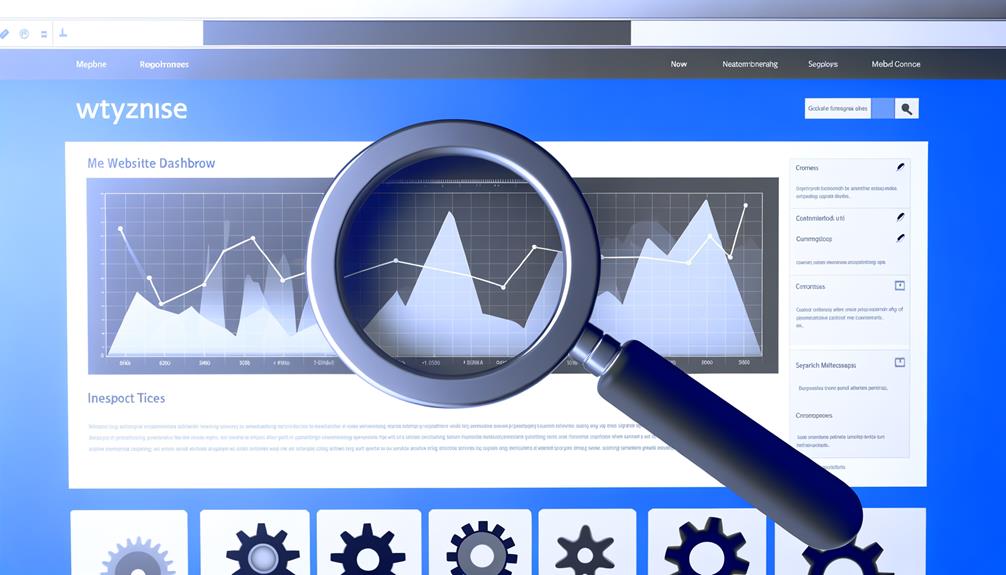In today’s digital landscape, the role of analytics and data tracking in enhancing website insights cannot be underestimated. These tools provide businesses with an unprecedented level of understanding into user behavior, enabling them to adapt their strategies for maximum impact.
By interpreting this data, companies can identify trends, optimize user experience, and ultimately drive growth. Yet, the question remains, how can these insights be best leveraged for success?
Let us explore this intriguing subject further.
Key Takeaways
Understanding the Basics of Web Analytics
To fully comprehend the fundamentals of web analytics, it is crucial to understand that it encompasses the tracking and analysis of website traffic, visitor behavior, and engagement, thereby providing valuable insights into website performance and user interactions. An analytical, detail-oriented approach is essential to leverage these insights effectively.
Key metrics such as sessions, users, pageviews, bounce rate, and average session duration paint a vivid picture of visitor behavior and engagement levels. Google Analytics, a popular web analytics tool, is instrumental in generating these metrics, allowing businesses to gauge the effectiveness of their marketing campaigns and optimize their online presence.
Web analytics not only offers a snapshot of current website performance but also serves as a roadmap for future improvements. By dissecting user interactions and engagement patterns, data-driven decisions can be made to enhance user experience and increase return on investment. In essence, web analytics forms the foundation for a robust online strategy, enabling businesses to understand, engage and grow their digital audience.
Through the effective use of web analytics, businesses can align their strategies to user needs, optimize their online presence, and ensure their marketing campaigns yield the desired results.
Importance of Data Tracking for Websites
In the realm of digital marketing, data tracking emerges as a critical factor, providing intricate insights into user behavior, preferences, and interactions on websites. It stands as a powerful tool, allowing businesses to harness the power of data and analytics to improve their online presence and make valuable, data-driven decisions.
Data tracking provides insights into user engagement as reflected in key metrics like bounce rate, session duration, and page views. This empowers businesses to identify areas that require improvement for optimal website performance.
Implementing data tracking tools, such as Google Analytics, enables businesses to monitor traffic sources, user demographics, and conversion rates. These insights are pivotal for informed decision-making.
Data tracking helps businesses understand the effectiveness of their marketing strategies. This, in turn, allows for the refinement of these strategies to increase conversions.
Data tracking enables businesses to create a more personalized user experience. By understanding user preferences and behavior, businesses can tailor their website and content to meet user needs.
To conclude, data tracking is not just a valuable asset but a necessity in today’s digital landscape. It provides the power to identify gaps, make improvements, and drive business success.
Setting Up Effective Data Tracking Tools

The process of setting up effective data tracking tools is a two-pronged approach: selecting the right tools and implementing them successfully.
The selection phase necessitates a thorough analysis of the various tools available, their features, and how they align with specific business needs.
Subsequently, the implementation phase involves correctly installing these tools to ensure they accurately track and report vital website data, thereby aiding in strategic decision-making.
Selecting Appropriate Tracking Tools
How does one go about selecting the most suitable tracking tools for gaining valuable insights into website performance and user behavior? Key considerations should include the tool’s ability to deliver thorough analysis of website traffic, engagement levels, and visitor behavior.
Here are four potent tools to consider:
The correct blend of these tools will expedite your understanding of user interactions and improve your website’s performance.
Implementing Tools Successfully
Having selected the most suitable tracking tools, successful implementation becomes the next critical step, involving strategic setup and consistent monitoring to extract valuable insights for optimizing website performance. Effective data tracking tools, such as Google Analytics, provide critical information on user engagement, conversion rates, and key metrics, enabling businesses to make informed decisions.
Interpreting Website Data for Insights
As we transition to the topic of ‘Interpreting Website Data for Insights’, it’s critical to recognize the power behind understanding website analytics and decoding users’ behavior patterns.
By meticulously analyzing different metrics and user interactions, we can gain a comprehensive understanding of our website’s performance and visitor engagement.
This process allows us to identify areas of strength and weakness, guiding data-driven decisions for website optimization.
Understanding Website Analytics
Delving into website analytics, such as user behavior, engagement metrics, and traffic sources, offers critical insights that can be harnessed to optimize content and enhance overall website performance. Understanding these dimensions of website data allows for data-driven decisions that can maximize your conversion rate.
Embracing these insights fosters a sense of belonging among your audience, as content is tailored to their preferences and behavior.
Decoding Users’ Behavior Patterns
Deciphering user behavior patterns through data analysis unveils invaluable insights about the most visited pages, click-through rates, and the average duration of user visits. Analyzing user behavior patterns helps us navigate the intricacies of user interaction, uncovering popular pages that engage users and keeping them longer on the site.
By tracking bounce rates and exit pages, we can identify areas for improvement, enhancing user experience and ensuring content relevance. This comprehensive understanding of user behavior can help optimize conversion funnels, streamlining the journey from visitor to customer.
Improving Website Performance Through Data

How can website performance be enhanced using data analytics?
The answer lies in the meticulous tracking and analysis of user behavior, traffic sources, and page performance. By leveraging data analytics, businesses can extract valuable insights to optimize their website, thereby improving its performance and bolstering their online presence.
Data analytics provides the tools necessary to make data-driven decisions for website optimization. This process involves:
Employing these strategies will not only improve the user experience but also increase the effectiveness of your digital marketing efforts. It’s all about tracking, understanding, and acting upon user behavior.
The power of data analytics lies in its ability to convert raw data into actionable insights, leading to a stronger, data-driven online presence.
Utilizing Google Analytics for Website Insights
Google Analytics, a robust tool for data analysis, offers comprehensive insights into website traffic, visitor behavior, and engagement patterns, thereby serving as a vital resource for optimizing website performance. It provides a suite of metrics including sessions, users, bounce rate, and conversion rate, that aid in measuring the effectiveness of marketing efforts.
Setting up Google Analytics is a straightforward process. It involves creating an account and installing a unique tracking code on your website. This tracking code enables Google Analytics to gather data insights and provide a detailed report on various metrics crucial for website optimization.
These reports from Google Analytics allow for the examination of acquisition sources, helping to understand where your traffic is originating, whether it’s from organic search, social media, or direct visits. Analysis of visitor behavior using these reports can highlight the high-impact pages on a website, and reveal areas that require further improvement.
Moreover, Google Analytics aids in optimizing website traffic. By identifying popular pages, analyzing referral traffic, and targeting specific keywords, it becomes possible to enhance user engagement and increase the conversion rate. Thus, Google Analytics proves essential for data-driven decision making and website optimization.
Leveraging Data to Understand Audience Behavior

Building upon the insights garnered from Google Analytics, it is essential to further leverage this data to gain a comprehensive understanding of audience behavior, thereby enabling the development of more effective strategies for website optimization. Analyzing customer behavior and interactions can provide valuable insights into website performance and user preferences.
This process involves:
These steps allow you to make data-driven decisions, optimize your content to your audience’s preferences, and ultimately achieve your business objectives. By leveraging data and tracking tools effectively, you can create a website that not only meets your audience’s needs but also contributes significantly to your business growth. This approach to audience behavior analysis lays the groundwork for continual website enhancement and growth strategy optimization.
Optimizing Website Traffic With Analytics
In the ever-evolving world of digital marketing, optimizing website traffic through strategic use of analytics has emerged as an indispensable tool for boosting online presence and driving business growth. One effective method involves analyzing high-impact pages to identify opportunities for improvement. This data-driven approach allows for better targeting of resources, enhancing website performance, and ultimately, user experience.
Referral traffic analysis is another key component for optimizing digital marketing strategies. By understanding where your traffic is coming from, you can tailor your content and marketing efforts to align with these sources, thereby increasing traffic and conversion rates.
Targeting long-tail keywords is also crucial. These specific keyword phrases, often less competitive yet more targeted, can lead to higher conversion rates through thorough research and strategic implementation.
Optimizing landing pages is another vital area. By utilizing data tracking and Google Analytics best practices, it’s possible to refine these pages to enhance user engagement and improve conversion rates.
Harnessing Analytics for Business Growth

Having explored the optimization of website traffic through analytics, we can now shift our attention to the critical role that these tools play in catalyzing business growth. By utilizing analytics, businesses can track website traffic, user behavior, and engagement metrics to make data-driven decisions that fuel growth.
In the quest for business expansion, the following points are crucial:
Analytics and data tracking not only provide businesses with invaluable insights into their website traffic but also help in understanding user behavior better. This understanding is instrumental in implementing effective marketing strategies, enhancing user engagement, and improving the overall user experience. The ultimate goal is to increase conversion rates and secure a robust online presence, all of which contribute significantly to business growth.
Frequently Asked Questions
How Do You Leverage Data and Analytics?
By implementing advanced analytics tools, predictive analytics power is harnessed to make data-driven decisions. Real-time data tracking, data quality management, and customer behavior analytics are utilized, alongside customized analytics solutions and data visualization techniques for comprehensive insights.
What Is the Purpose of Data Analytics Is to Gain New Insights From Data?
Data analytics aims to gain new insights from data, enhancing the decision-making process through data interpretation, predictive analytics, and insightful visualization. It empowers businesses with real-time reporting and insightful dashboards for data-driven strategy and improved customer behavior understanding.
What Does Leverage Insights Mean?
Leveraging insights refers to the strategic application of data-derived knowledge, or insights, to improve business operations. It involves the interpretation of actionable insights to positively impact business, despite challenges like data quality.
How to Use Data Analytics to Drive Better Business Insights?
How can predictive analytics, customer segmentation, and behavioral analysis enhance sales forecasting? Through market research, conversion optimization, social media analytics, competitive analysis, risk assessment, and operational efficiency, data analytics drives superior business insights.
Conclusion
In conclusion, the role of web analytics and data tracking in enhancing website performance is like finding a needle in a haystack. It enables businesses to pinpoint areas of strength and weakness, thereby guiding strategic decisions.
Utilizing tools like Google Analytics can not only optimize website content and traffic, but also provide a deeper understanding of audience behavior.
Thus, harnessing analytics is a key step towards business growth in the digital sphere.


